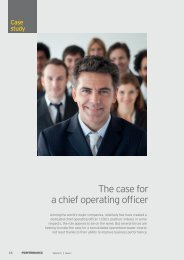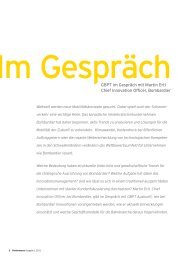PERF RMANCE 04 - The Performance Portal - Ernst & Young
PERF RMANCE 04 - The Performance Portal - Ernst & Young
PERF RMANCE 04 - The Performance Portal - Ernst & Young
You also want an ePaper? Increase the reach of your titles
YUMPU automatically turns print PDFs into web optimized ePapers that Google loves.
Competing for market share in<br />
rural India<br />
Deployment of appropriate funding<br />
methods and effective monitoring of<br />
the funds deployed led to a significant<br />
improvement in the dealers’ profitability<br />
and enhanced their ability to service the<br />
market more effectively.<br />
3. Sales force effectiveness<br />
Another critical aspect was the<br />
effectiveness of the sales force (including<br />
both the client’s and the dealers’ sales<br />
forces in the local markets). Based on<br />
the analysis, we found contact by a sales<br />
person during the sales cycle was one of<br />
the most critical components impacting<br />
successful sales performance (see<br />
Figure 9).<br />
Analysis of customer buying behavior<br />
revealed that customer conversion<br />
dramatically drops when the salesman<br />
has not met the customer during the sales<br />
process. For example, conversion ratio<br />
was 36% when a company salesman met<br />
the customer, irrespective of whether the<br />
customer visited the dealership or not.<br />
Conversion ratios went up to 48% when the<br />
customer visited the dealership and was<br />
visited by the salesman. However, when<br />
the salesman did not contact the customer<br />
during the sales process, the conversion<br />
was only 5%, irrespective of the customer<br />
having visited the dealership.<br />
As a consequence, running initiatives to<br />
increase the number of sales personnel<br />
(of both company and dealer) in the<br />
market and also increasing the frequency<br />
of visits made to a customer during<br />
the sales process dramatically improved<br />
sales performance.<br />
Overall impact<br />
By focusing on the key elements of the<br />
client’s distribution equity and introducing<br />
some very specific changes, the effect<br />
was a significant overall improvement<br />
within a very short period of time (see<br />
Figure 10). While only part-way through<br />
implementation, the client witnessed a 50%<br />
increase in its market share and is currently<br />
looking at rolling out a similar program<br />
across its entire network within India.<br />
Figure 10. Sales and market share<br />
performance<br />
8%<br />
180<br />
90<br />
11.21%<br />
226<br />
83 100<br />
12.35%<br />
253<br />
Figure 9. Analysis of customer buying behavior<br />
December January February<br />
Customer conversion driver<br />
Customer conversion ratios<br />
Implementation launch — mid December 2010<br />
FY 09<br />
FY 10<br />
Salesman contact<br />
Dealership visit<br />
36%<br />
Summary<br />
Salesman contact<br />
Salesman contact<br />
Dealership visit<br />
Dealership visit<br />
48%<br />
5%<br />
While organizations spend significant<br />
amounts of time and effort in developing<br />
their brand equity, in rural India, given<br />
the nature of the market, it is critical<br />
for organizations to focus equally, if not<br />
more so, on their distribution equity. We<br />
believe this will yield greater returns to<br />
organizations planning to succeed in rural<br />
markets in India.<br />
67






